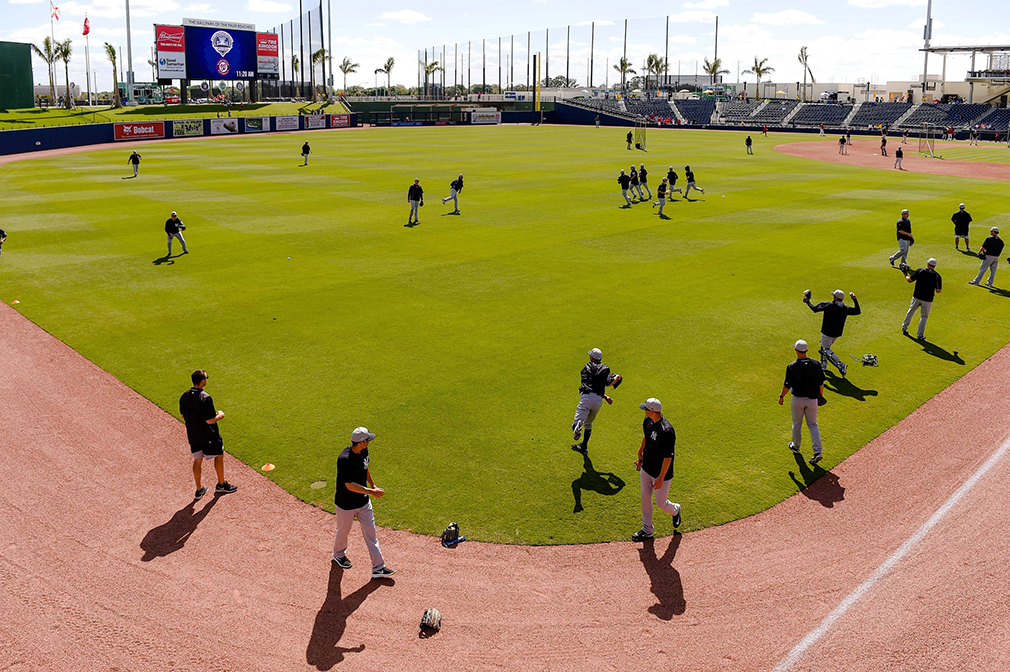When I talk to any casual baseball fan about spring training results, they usually fall into one of two camps. The first camp has the people that overreact to spring stats, and if this is you, then please know that this isn’t a good camp to be a part of.
Stop me if you’ve heard this before, but spring training stats are to be taken with a grain of salt. In other words, Brett Gardner isn’t all of a sudden a terrible baseball player because of his .194/.216/.278 line, and Tyler Wade isn’t the second coming of Derek Jeter because of his .464/.500/.571. Out of all of the most common sabermetric stats that we have out there that we like to use, the one that takes the shortest sample size to stabilize is strikeout rate, and that takes about 60 plate appearances. Aaron Judge leads the Yankees with 42 plate appearances currently. None of the Yankees will probably reach 60 plate appearances this spring, and remember, strikeout rate is the first metric to stabilize. A sample this small shouldn’t cause you to question everything you know about baseball and baseball players.
Some players work on their swing maniacally in the offseason so that they’re absolutely 100% game-ready by the start of spring because they’re so eager to impress the coaching staff. Other players don’t do anything other than tee work until January or even early-February. Oftentimes, pitchers aren’t in regular season form, either. They may be working on a new pitch or a new delivery, or even a new pre-game routine, and because spring wins and losses don’t matter, they’re not worried about the results. Maybe some of the hitters are working on something as well that they may not be trying if it were in the regular season. Not all of the pitchers that the hitters face in the spring will be of major league-caliber, either. Because of rest and big roster sizes and the World Baseball Classic and split squads and extreme injury risk aversion and plenty of other reasons, there are countless players appearing in spring games that will never step foot in a major league game this season. In other words, the sample size for spring training stats is too small to draw any conclusions from, but even if it were large enough, the games and the match-ups aren’t indicative of what will go on over the majority of the major league regular season.
However, there is another camp that believes that spring training performance means absolutely nothing simply because it’s in spring training, and I don’t believe that to be a wise line of thinking, either.
When I say “performance”, I’m not just referring to statistics and results. I’m also talking about everything else physical (and maybe mental) that happens in game situations in spring training. Don’t forget that statistics are just one half of the game of projections — scouting is the other. When a pitcher adds a new pitch to his arsenal, and you can tell from the eye test that it’s looking sharp, that pitch doesn’t need a sample size to “stabilize”. If you watched CC Sabathia last spring and noticed his increased cutter usage leading to weaker contact, you probably weren’t surprised with the regular season results. Sabathia’s ERA dropped almost a full run from 2015 to 2016 as his cutter usage went from 3.0 percent to 29.3 percent. We did indeed witness weaker contact as well — Sabathia’s home run rate dropped from 1.51 per nine innings to 1.10, while his batting average against went from .281 to .248. Perhaps most evidently, CC Sabathia allowed an average exit velocity of 88.1 miles per hour in 2015 (outside of the top 60, among pitchers with min. 190 batted balls recorded), but that number plummeted to 85.3 mph in 2016 (second in all of baseball among pitchers with the same qualifier).
It’s not just about a pitcher with a new pitch, though. A hitter can have new, improved swing mechanics, or laser surgery, or a new mental approach, or a whole other cast of tangible and intangible improvements. But the point is that they may matter, and you may first witness it in spring training. Maybe a hitter lays off two tough breaking balls in two-strike counts, then rifles a ball the other way that just happens to catch the second baseman in the square of the chest. We won’t know if those were things that he worked on in the offseason, but that at-bat is still another data point.
If you happen to be in the second camp that believes spring means nothing, then I have a question for you — what is even the point of spring training? If stats don’t matter, then why not just give all of the spring in-game repetitions to the players that the front office thinks are the best 25? Why have non-roster invites (other than in case of injury), and why play the entire 40-man roster?
I truly believe that the average readership here is of a much higher level than the casual baseball fan, but this is still a disclaimer worth mentioning. Spring training doesn’t matter, but it also does.
Photo: Steve Mitchell/USATSI
